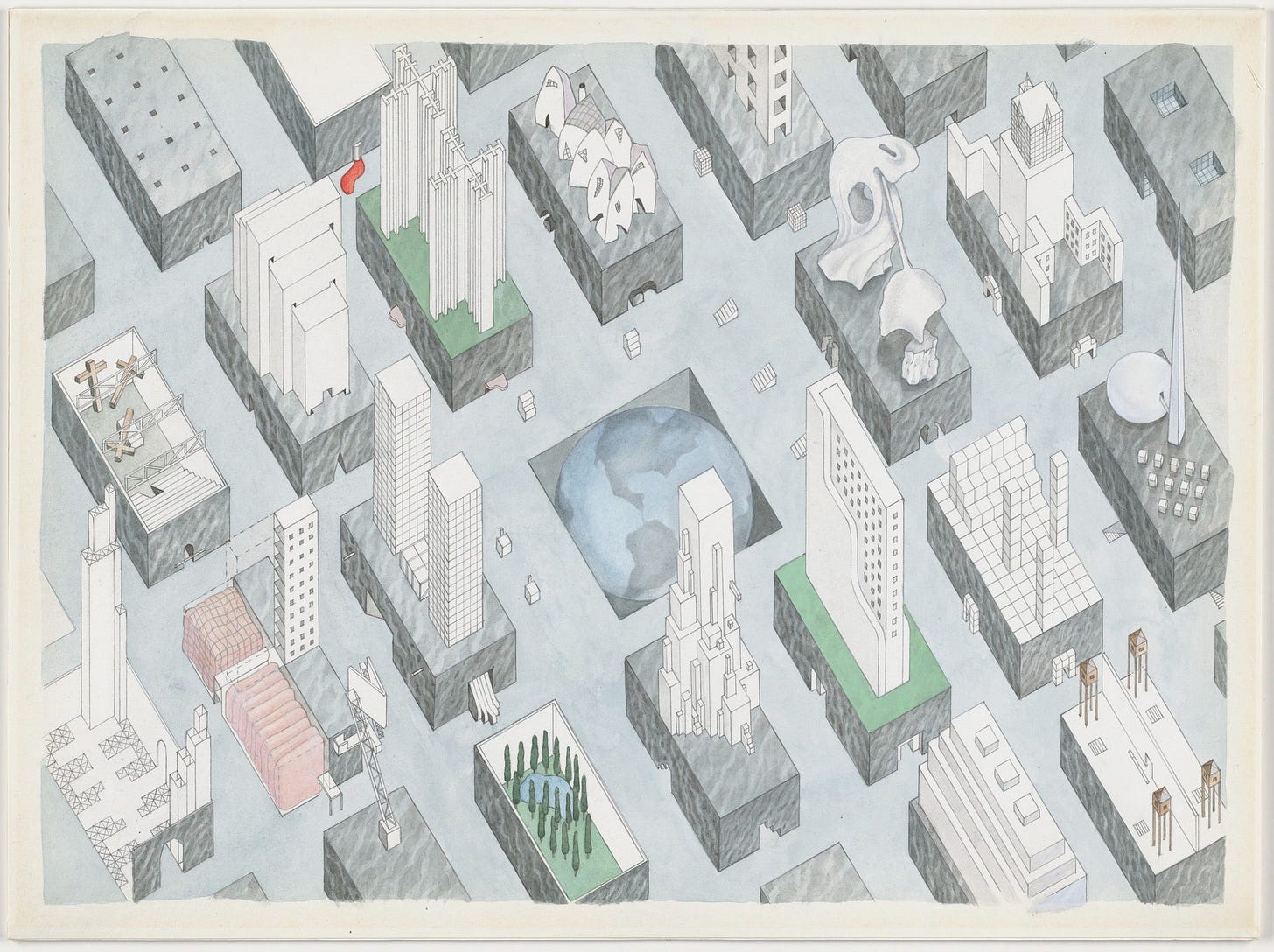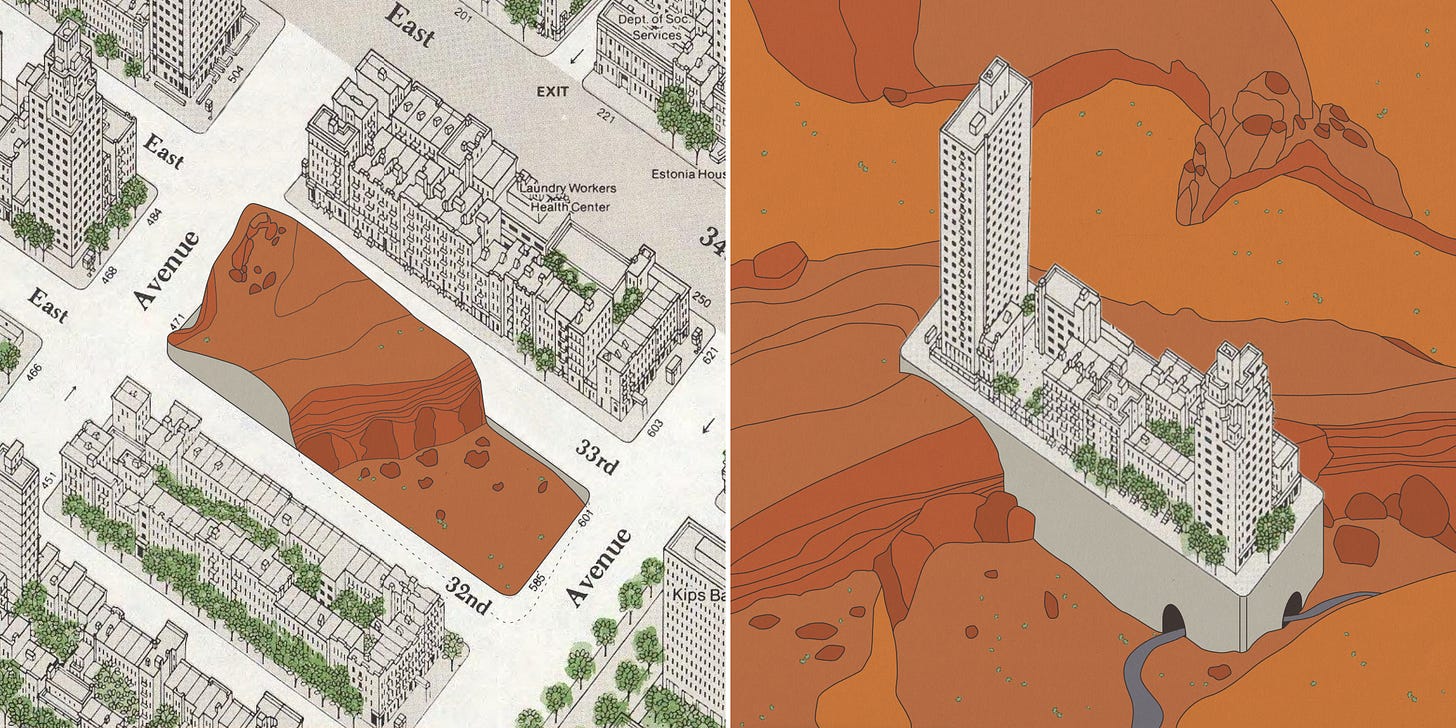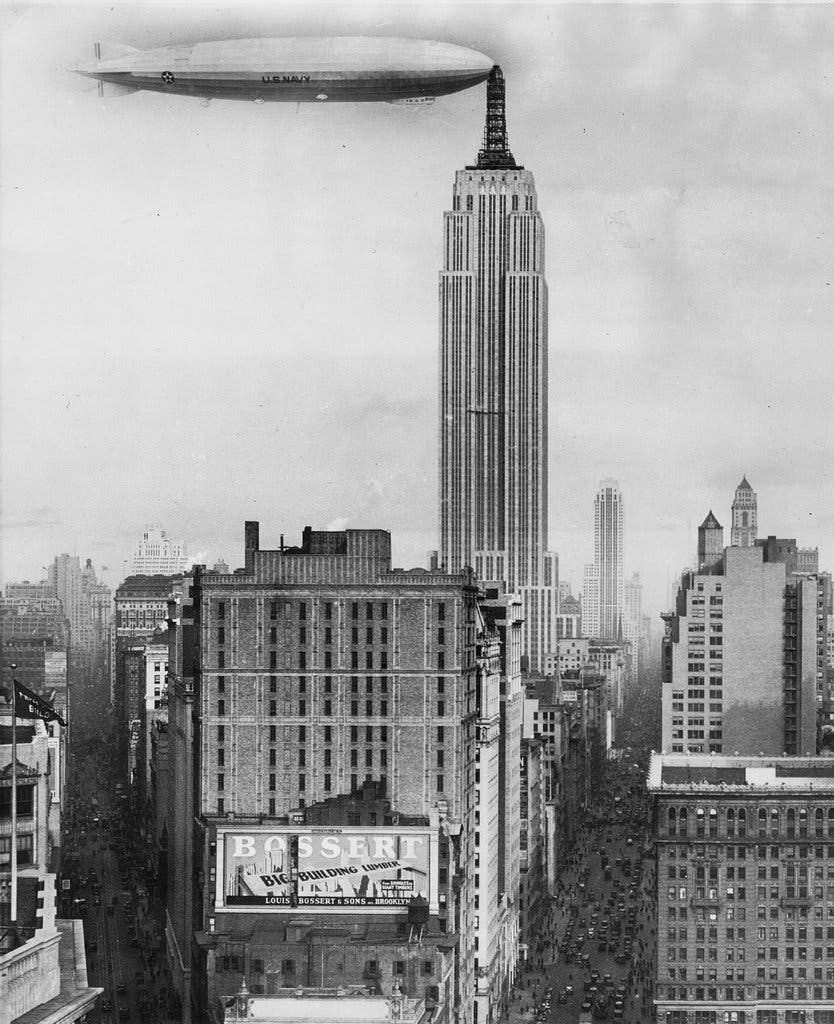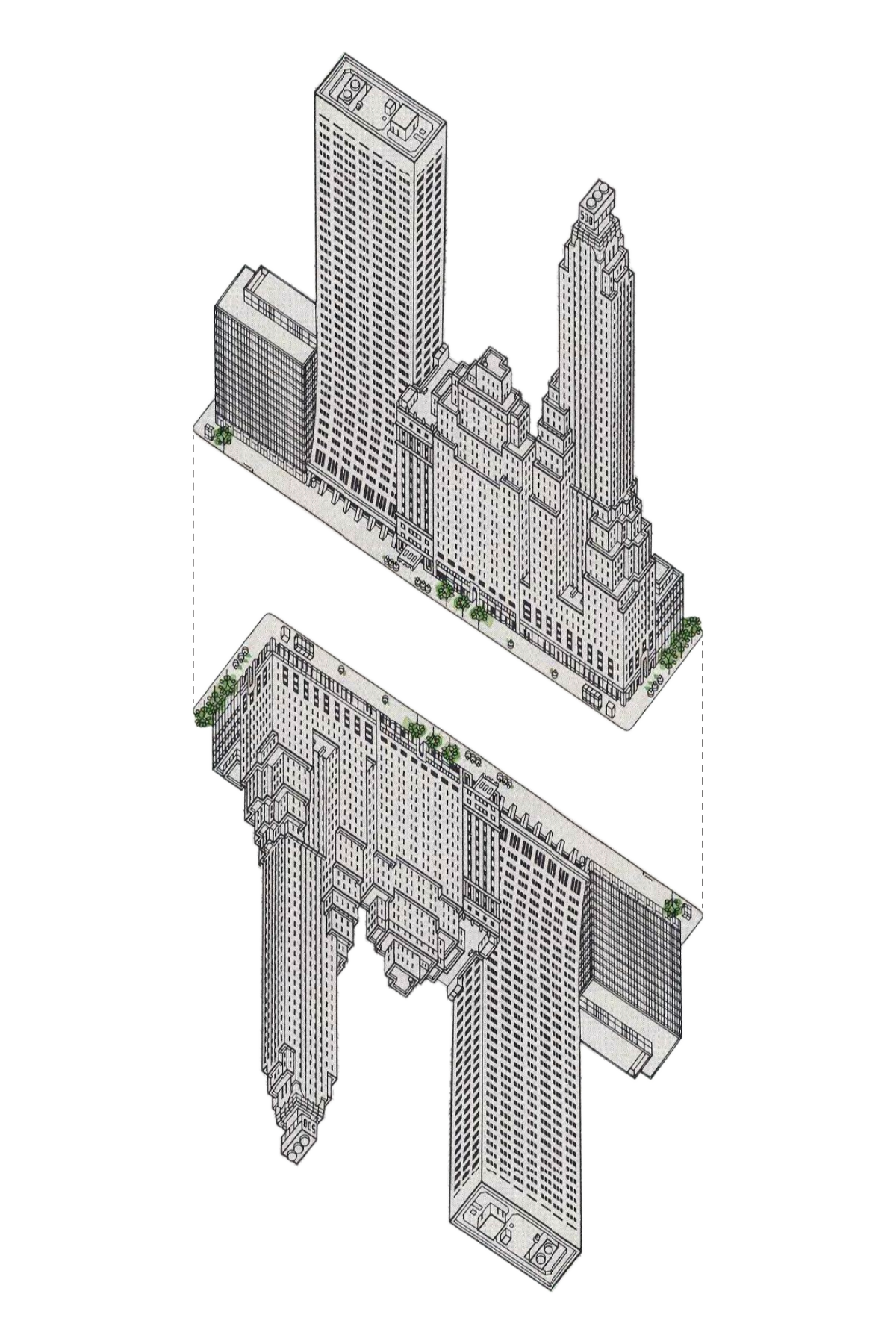Introducing...Block-For-Block
A Cultural Exchange Program For The Borough Of Manhattan
Dear Readers,
You Have Perhaps Seen The Latest "Viral” Proposal For Urban Innovation In New York City. Dubbed “New Mannahatta,” The Scheme Aims To Build Up Over 1700 Acres Of New Land In The New York Harbor South Of Battery Park City, Replicating The Upper West Side In Density And Built Form.
I Do Not Think This Particular Idea Is Feasible Or The Best Use Of Resources, For Reasons Which Others Have Discussed At Length On Twitter And Other Platforms. But I Applaud The “Swinging For The Fences” Quality Of It, And Have An Appreciation For Big Gestures.
This Is Far From The First Grand Proposal For Revitalizing The Big Apple. Some Other Greatest Hits Include Work By The Dome-Loving Buckminster Fuller, The Italian Collective Superstudio, And Architecture Twitter’s Resident Enfant Terrible Kevin Rogan.

What These Proposals Have In Common Is A Desire To Add Built Form To The City. That May In Fact Be The Right Approach, But I Think It’s Worthwhile To Explore Some Alternative Philosophies.
What I Have Developed Over The Past 72 Hours Is A Novel Exchange Program To Extend Manhattan’s Cultural Reach Without Adding Density. If Anything, This May Relieve Some Of The Strain On The City’s Struggling Subway System And Social Services.
How Does It Work?
The Program, Which I Am Calling “Block-For-Block,” Is Simple. One Full City Block Of Manhattan Real Estate (Buildings And Landscaping Included) Is Extracted From The Island And Shipped Elsewhere In The United States. A Parcel Of Equivalent Dimensions Is Excised From Its “Natural” Location And Sent To Manhattan In Return.
Let’s Walk Through Some Examples.
I’m Using With Imagery From Constantine Anderson’s Beautiful Map Of Midtown Manhattan. My Parents Have A Copy Of This On The Wall In My Childhood Home, And Staring At Its Richly Detailed Linework Was One Of My Earliest Appreciations Of Grind. Similar Maps Have Been Drawn By Hermann Bollman And Tadashi Ishihara. All Three Are Worth Looking At. Also Percolating In The Formal Background Of This Scheme Is Rem Koolhaas and Madelon Vriesendorp’s 1972 City Of The Captive Globe Drawing.
A Drawback Of Using The Anderson Map Is That No Developments After 1985 Are Shown. Likewise, The Map’s Boundaries Mean That Large Portions Of The Borough Are Not Represented. But Let’s Get Back To The Task At Hand.
Here We Have A Perfectly Nice Slice Of 32nd Street, Between 2nd And 3rd Ave. According To Present Day Google Maps, This Block Has A Dunkin, A Starbucks, And A Comic Book Store, As Well As Manhattan PS 116.
Now, With The Block-For-Block Program, This Charming Parcel Could Be Exchanged With A Lot Of Equivalent Size In Eastern Utah, Specifically The Area Of Arches National Park. Of Course, There’s A Bit Of Infrastructure Work To Do In Order To Account For A Substantial Difference In Topography, But We Can Talk Details Later.
Now We Have Some Hiking And Climbing Options In The Heart Of The Metropolis And We’ve Added Some Density To A Sparsely Populated Area Of The Western US. It’s That Easy.
Let’s Look At Another.
I Think We Could All Agree That International Relations Could Be Improved With A Bit More Teamwork And Collaboration From All Parties Involved. Perhaps Something In The Site Of The United Nations Building Itself Contributes To The Tensions We Face As A Planet. One Strategy That The Block-For-Block Program Enables Is Moving The UN To A Part Of The Country With More Of A Reputation For Team Spirit And Hospitality. I Can Think Of No Better Place Than Dyersville, Iowa, Best Known As The Setting Of The 1989 Academy-Award Nominated Kevin Costner Film, Field Of Dreams.
I Believe Our Diplomats And NGOs Could All Benefit From The Fresh Air, And Everyone In Manhattan Will Love More Public Greenspace By The East River.
With International Relations Sorted Out, We Can Attempt To Heal Some Divisions Domestically. Suppose The (Recently Demolished) SOM-Designed 270 Park Avenue Were Swapped With A Portion Of Lima, Ohio. As The World Headquarters Of JPMorgan Chase And A Perfectly Pleasant Midwest Suburb Respectively, What Better Pair To Unpack The Main St Vs. Wall Street Divide In Our Country.

Another Idea: Relocating Madison Square Garden To The Capricorn Ridge Wind Farm In Sterling City, Texas (And Vice Versa).
I’ll Be The First To Admit: Laying 1800 Miles Of New Track To Maintain Connectivity For Penn Station May Be A Sticking Point For Some. But Think Of The Jobs It Could Create, Not To Mention The Possibility Of Connecting Through Cities Like Roanoke, Nashville, Memphis, Little Rock, And Dallas. By Just Swapping One Block, We Can Carve A Path Of Innovation Through The Heart Of The Country.
At This Point, You May Be Wondering About The Logistics Of Swapping Out Entire City Blocks, Particularly Without Disrupting Daily Life In The Surrounding Neighborhoods. Scientists And Engineers Will Need To Do The Hard Calculations, But In Theory A Fleet Of Purpose-Built Blimps Could Attach To The Structural Framing And Foundations Of The Blocks In Question And Carry The Parcels Through The Air.
As You Can See Above, We’ve Successfully Attached Airships To Manhattan Before. To Do It Again And Achieve Sufficient Lift Is Just A Numbers Game.
These Are Just What I Can Put Together In A Weekend, But I’m Confident That The Opportunities Here Are Limitless. Suppose The New York Times Building Participated In An Exchange With Rural Tennessee. Times Reporters Could Interview White Working-Class Trump Supporters Without Getting On A Plane. Or Imagine A Block Of The Florida Everglades Right On Fifth Avenue. The Guggenheim Manhattan Goes To Bilbao And The Guggenheim Bilbao Comes To Manhattan. Wouldn’t That Be Neat?
All Vitruvius Grind Readers Are Encouraged To Make And Share Their Own Proposals For A Block-For-Block Exchange. With Enough Grassroots Support, We Can Turn This Program Into A Reality.
The Fine Print
Now, Some Readers May Have Reservations. I Understand And Appreciate Those Concerns And I’ve Done My Best To Anticipate And Respond To Some Likely Critiques Below.
Would This Even Work?
It’s Possible. It May Not Be Practical, But Moving Astronomical Amounts Of Earth Around Isn’t All That Different From Moving Smaller Amounts Of Earth Around Many Times Over. Same For The Built Structures.
Wouldn’t This Be Expensive?
Oh, Certainly—Astronomically So. Not To Mention Incredibly Time-Consuming And Potentially Very Disruptive. But That’s Only Half The Equation. If Implemented Correctly, This Project Has The Possibility Of Generating Incredible Value For Early Investors.
As Far As Both Feasibility And Cost Are Concerned, I Believe We Can Satisfy The Critics By Demonstrating An Effective Block-For-Block Exchange Between The West Village And Jersey City. Yes, It’s A Bit Like Sending A Postcard To Your Next-Door Neighbor, But It’s A Cost-Effective Way To Work Out Any Kinks.
How About Connecting To City Services? How Is Infrastructure Maintained Between Sites? How Do You Prevent Disruptions To Existing Natural Ecosystems? Who Decides Which Blocks Are Exchanged And Where They End Up? What Model Of Governance And Jurisdiction Is Appropriate Here? What Is The Timeline For All Of This? Etc.
Literally Do Not Worry About It. Did You Even Look At The Renderings? They Show A City And A Countryside That Are Thriving—Are You Against Thriving?
Now, I Could Give You Some Cherry-Picked Statistics About Cost Per Square Foot For Much Simpler Endeavors And Hope You’ll Trust Me That It Applies Equally Here. I Could Explain That We Will Keep A Decentralized Crypto-Based Register Of All Decisions Relating To The The Block-For-Block Program (We Will Call It “The Blockchain”). I Could Tell You That My Best-Case Scenario Calculations (Factoring In Technologies Yet-To-Be-Developed) Vastly Outperform The Most Cynical And Pessimistic Estimates For Technologies We Know And Understand Well.
And If That’s Somehow Still Not Enough, I Hope To Announce Some Special Celebrity Partners In The Coming Months Who Will Add Their Expertise In Business, Media, And Leadership To Our Portfolio.
Against New Mannahatta
Readers, May I Be Very Candid With You?
I Do Not Think Many Of Today’s Headline-Grabbing “New City” Proposals Are Destined To Succeed. And I Do Not Want Them To.
“New Mannahatta” Is Only The Latest In A Long, Long Line Of Grand Proposals To Transform City Life. We Have Been Trying To Perfect The Urban Form Since Probably The Dawn Of Agriculture And Permanent Human Settlements.
You Can Read Much Better Writing About The Occasional Successes And Frequent Failures Of Utopian Cities In Other Places. (Two Favorites Of Mine Are Dolores Hayden’s Seven American Utopias And WORKac’s 49 Cities.)
Kate Wagner, One Of Our Discipline’s Most Talented Critics, Has Written About These Sorts Of New City Schemes As What She Calls “PR-chitecture.” Her Piece Is Well Worth Reading In Full, But A Brief Excerpt Captures Much Of My Frustration With New Mannahatta And All The Rest:
“PR-chitecture sucks the air out of architecture…It dumbs architecture down, substituting any abstraction or critical impulse with buzzwords and glossy pictures of tree-lined high-rises. The future and the rich tapestry of all its potentialities and possibilities are co-opted by insipid technological bandwagon-hopping.”
For All Their Bold Promises And Flashy Renderings, These Proposals Rarely Address Any Of The Root Causes Of What Ails Our Cities. Most Don’t Even Want To. To Fund New Mannahatta, The Proposal’s Author Claims “it can pay for itself through sales or long-term land leases.” I Am, Shall We Say, Deeply Skeptical That We Can Construct And Sell Off 1800 Acres Of New Real Estate In New York City Without Perpetuating Many Of The Gross Inequities And Structural Forces Of Capital That Underpin The Current Housing Crisis.
Or, Consider The Below, From The Flashy Pitch Website For BIG And Marc Lore’s Proposed Desert-Utopia, Telosa:
Ask Yourself: When The Goals Of “Transparent Participatory Democracy” Find Themselves At Odds With The Private Endowment Who Owns And Manages The Land, Which Party Wins?
Yes, Some Have Proposed That Cryptocurrency And Decentralized Smart Contracts Are The Silver Bullet To Issues Of Financing And Governance For These Sorts Of Large-Scale Visions. I Don’t Mean To Be Uncharitable To The Crypto Community. I Will Grant That There’s A First Time For Everything And That Any Real Paradigm-Shift Will Probably Look A Little Silly At First. But, Two Large Crypto-Based Projects Have Hit Rather Embarrassing Hurdles In The Past Week (CityDAO, Theft; SpiceDAO, Copyright Law), And It Should Be Enough To Make Any Potential Crypto-City Backers Question Carefully What Exactly They’re Paying For And How Airtight The Plans Really Are.
Non-Trivial Questions Of Funding And Management Aside, The Underlying Technology For These Proposals Needs To Actually Work. The Radical Downgrade Between Expectation And Reality In Elon Musk’s Boring Company Projects Should Give Us Pause. Musk Promised A Reprieve From Traffic Jams With A High Speed, Space-Age Transit Network Of Subterranean Tunnels. In Practice, Musk’s Tunnel Experiments In Las Vegas Have Simply Moved The Traffic Jams Underground.
What Is Block-For-Block, Then? To Call It Parody Might Lend Undue Seriousness To The New Mannahattas Of The World. None Of These Proposals Will Ever Happen, Not In Any Serious Way. They’re Far Too Extravagant In Scope And Vacuous In Vision. Feel-Good “Big Ideas” For The TED Talk Crowd. Dredge Up Half Of New York Harbor To Build Another Upper West Side? Join In With Bjarke Ingels To Create Burning Man: 2049? We May Just As Well Use A Fleet Of Blimps To Carry Manhattan Away In Bits And Pieces.
This Isn’t To Say We Shouldn’t Or Can’t Do Big Things. I Hope We Do. I Would Like For Us To Draw Grand, Mesmerizing, Fantastical Schemes—Cities Organized By Forces Other Than Profit; Natural Resources Looked At Through A Lens Of Restoration Rather Than Extraction; Places For Grandparents Walk About, Listening To The Birds And Watching The Children Play; Real, Functional Public Transit; Bathrooms You Can Use Without Buying Anything; A Genuine Civic Life Not Mediated By A Smartphone Or A Startup.
We Could Do Worse Than New Mannahatta. But We Deserve So Much Better.
—Vitruvius Grind














